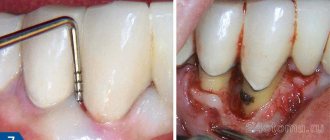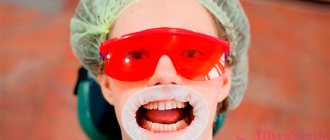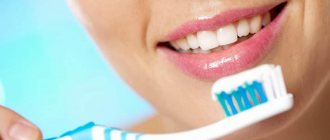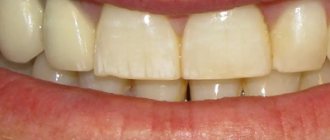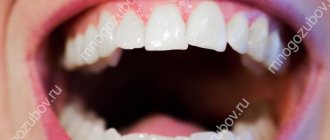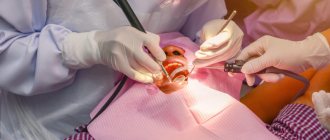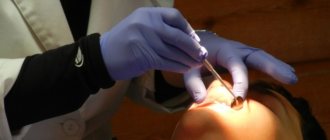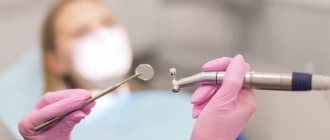Healthy teeth and a beautiful smile are not a gift from nature, they are daily care and proper protection. Daily brushing of your teeth using professional products, mouth rinses, and dental floss will help you protect your teeth from caries and other oral diseases. But, unfortunately, it is not always possible to completely clean your teeth even in the most secluded corners - this is how plaque appears on the teeth, and later tartar , which cannot be removed with a paste and brush. This will require professional teeth cleaning at the dentist's office.
To maintain the effect of the procedure and protect your teeth from various damage and diseases, you must follow a number of doctor’s recommendations, because teeth require special care after brushing. Family Dentistry Medical Center offers you a list of the most important tips:
Preventive measures
To avoid inflammatory processes in the oral cavity and relieve mild pain in the teeth, which sometimes occurs after removing tartar, you can rinse your mouth with medicinal decoctions, for example, St. John's wort, sage or even chamomile tea, which can be purchased at any pharmacy. If your teeth or gums continue to bother and hurt for a long time after hygienic cleaning, you should consult your doctor to make sure everything is okay.
Professional teeth cleaning, as well as home care, is an important and necessary procedure. By following all the doctor’s recommendations, not forgetting about the rules of hygiene, as well as regular preventive visits to the dentist and timely treatment, this is the only way you can protect your teeth from various diseases and defects. The health and beauty of your teeth depends on you, so take care of them from an early age!
Teeth hurt after ultrasonic cleaning: what to do?
Ultrasonic tartar removal is a modern way to get rid of hard deposits that cause infectious diseases of the oral cavity. This is a safe and comfortable procedure that is recommended for everyone, even pregnant women. But there is an exception to the rule - these are patients with thin damaged enamel, the ultrasound effect on which can cause pain both during and after sanitation
The fact is that tooth sensitivity may increase after ultrasonic cleaning. Therefore, before going for this procedure, you need to consult a dentist.
What is ultrasonic cleaning
Ultrasonic cleaning uses special dental equipment - an ultrasonic scaler. The principle of its operation is to generate ultrasonic waves, which, when they hit the surface of a tooth, soften plaque of varying degrees of density and remove it. In order to achieve maximum effect, the amplitude and frequency of the waves are adjusted individually for each patient. After treatment, the tooth surface becomes smooth and shiny, and also brightens by 1-2 tones.
Why can teeth hurt after ultrasonic cleaning?
If a patient’s teeth hurt after ultrasonic cleaning, this can be caused by two reasons. First of all, increased sensitivity of teeth associated with defects or damage to the enamel. Therefore, before using this service, you should strengthen your tooth enamel with fluoride-containing products and carry out a deep fluoridation procedure in a dental clinic. The second cause of pain after ultrasonic cleaning is inflammatory diseases of the oral cavity: periodontal disease, gingivitis, caries and others. Scaling may be necessary to treat these conditions. In this case, to relieve the patient from pain during the procedure, dentists use local anesthesia. The doctor will also prescribe painkillers and anti-inflammatory medications to take after ultrasonic cleaning.
What to do if your teeth hurt after ultrasonic cleaning
You can relieve pain after ultrasonic teeth cleaning at home. Applications with antimicrobial anti-inflammatory drugs (for example, Metrogil-denta, Traumeel S and others) will help relieve inflammation, relieve pain, and relieve swelling of the soft tissues of the oral cavity. If the neck of the tooth is particularly sensitive, toothpastes containing fluoride and herbal rinses should be used to care for the oral cavity. If a set of home hygiene procedures does not help relieve pain and/or it intensifies, then you need to visit a dental clinic, where specialists will select adequate treatment.
Expert opinion
Strict adherence to your dentist’s recommendations for oral care will help you avoid pain after ultrasonic tartar removal. Doctors advise brushing your teeth every time after eating on the first day after the procedure, using a soft brush and toothpaste for sensitive teeth.
It is also necessary for the first time to avoid eating cold, hot, spicy and sour foods, which have an aggressive effect on sensitive enamel.
Agree, these are quite simple and feasible medical prescriptions! If they are followed, removing tartar with ultrasound will be extremely comfortable - after all, this is the safest and most painless way to get rid of tartar used in modern dentistry.
Why does it hurt to brush healthy teeth if you have hypersensitivity?
Sometimes a dental examination does not reveal caries, pulpitis, periodontitis and other diseases. But the pain during cleaning remains. In this case, most likely, we are talking about increased sensitivity of the teeth.
According to statistics, more than 50% of the population have increased tooth sensitivity. This is the name for a condition in which dentin, a porous layer located under the enamel, is exposed. It contains tubules - microchannels leading to nerve endings. When the dentin tubules are exposed, the nerves become vulnerable to any irritants, the tooth reacts with acute pain to cleaning, touching hot and cold food. Dental hypersensitivity can occur for several reasons:
- eating sour or sweet foods,
- too much pressure when cleaning or incorrect selection of bristles stiffness;
- habit of grinding teeth;
- professional teeth cleaning, whitening.
These reasons can cause thinning of the enamel, promote the growth of bacteria and have a destructive effect on the gums, resulting in increased tooth sensitivity.
This condition causes serious discomfort to a person and prevents them from living a normal life. Ordinary everyday activities - eating, brushing and rinsing teeth, exposure to cold air - cause pain and distract attention from other activities. People with this problem find it difficult to concentrate on work or school, because the slightest reason can trigger another attack of pain.
Types and differences of professional teeth cleaning
There are various ways to clean your mouth professionally. Each option has advantages and disadvantages. The choice of technique is made by the dentist.
Ultrasonic
It is performed using a special device - an ultrasonic scaler. The working element of the device is equipped with a nozzle that performs oscillatory movements at an ultrasound frequency of 25-50 kHz. The effect is enhanced by supplying an antiseptic solution or water through the nozzle. Deposits are removed under the influence of cavitation.
This method does not damage the enamel. When treating the oral cavity with an antiseptic, pathogenic bacteria are destroyed. The effectiveness is so high that it is possible to cope even with supra- and subgingival stones. The patient does not feel pain after brushing his teeth.
Laser
Removal of mineral deposits and plaque from the surfaces of the oral cavity is carried out under the influence of a laser beam. The liquid evaporates from them, as a result of which the destruction process begins. Peeled particles are removed with a stream of water supplied under high pressure.
The cost of the service is higher than alternative methods, due to the use of expensive equipment.
Sandblasting
Cleaning is performed using Air Flow equipment. The device even copes with old deposits. The main condition is that the coating must be soft. Air Flow does not remove tartar. The process of sanitation of the mouth involves the use of a special attachment, a mixture containing a fine abrasive, and a fixing gel. This method is used with caution in cases of increased sensitivity of the gums.
Chemical
The essence of the procedure is to apply a special gel containing hydrogen and acid to the teeth. During aging of the product, hard and soft deposits are destroyed under the influence of chemicals.
The method is painless and effective. But the interdental areas are poorly treated.
Mechanical
Sanitation is carried out using brushes and highly active pastes. This method requires more time than alternative options. But the result is high. However, in the process of mechanical impact with brushes, the risk of damage to the enamel increases. For this reason, specialists rarely resort to such cleaning.
What is ultrasonic teeth cleaning
The main purpose of ultrasonic teeth cleaning is to remove hard deposits from the surface of tooth enamel. The so-called “tartar” is a mineralized plaque formed from decomposed food debris. But you shouldn’t think that stone can only occur in people who do not practice oral hygiene responsibly enough. It is impossible to remove all plaque with a regular brush, so the process of its mineralization occurs in absolutely all people. But, if a person smokes or drinks too much coffee or tea, then this stone becomes visually noticeable.
Ultrasonic cleaning is a painless and effective method. In addition, it is non-contact because the dentist's instrument (ultrasonic scaler) does not touch the teeth. This eliminates the possibility of scratches and other negative mechanical damaging effects. The scaler produces silent oscillations with a frequency of 16 to 45 thousand hertz. They are the ones who destroy mineralized deposits, crush them into tiny fragments, which are then washed off with sprayed water. The frequency level of the scaler is selected by the doctor depending on the area being treated.
Important: the procedure should only be performed by a qualified specialist using professional equipment in a dental clinic. Otherwise, there is a risk of harm to the health of teeth, gums and the body as a whole.
Indications and contraindications for
Indications:
- Pigmentation of tooth enamel
- Bad breath
- Bleeding gums
- Dentures (for correct selection of denture color)
- Before installing braces
- Before performing chemical bleaching of the enamel layer
Contraindications:
- Asthma, bronchitis
- Nasal congestion
- Severe cardiovascular disorders
- Installed pacemaker
- Any disease in the acute stage
- Epilepsy
- Serious neurological pathologies
- Age up to 18 years
- Presence of implants, crowns, “bridges”
- Purulent lesions of oral tissues
Rehabilitation after the procedure
To prevent gum inflammation from starting after the procedure, and for the results to last for a long time, the patient is required to properly care for the oral cavity.
What is required from the patient:
- Do not consume coloring foods and drinks for the first 24 hours after the procedure. These products include: colored fruits, vegetables and berries, coffee, red wine and natural juices.
- Immediately after the procedure, do not drink too hot or cold drinks.
- Immediately after brushing, replace the old toothbrush with a new one.
- Not only use a toothbrush twice a day, but also use dental floss and irrigator at least once a day.
- Be sure to visit your dentist every six months for a routine preventive examination.
- Do not neglect professional teeth cleaning, undergo the procedure regularly according to the indications of a specialist. As a rule, doctors recommend undergoing a comprehensive cleaning twice a year.
What do dental stones lead to?
- Halitosis (bad breath) – bacteria that are part of dental plaque produce sulfurous substances that have an unpleasant odor. You can try to mask it with special sprays, chewing gums and perfumed rinses, or remove the source of its occurrence (i.e. tartar and plaque).
- Inflammation of the gums (gingivitis and periodontitis) – inflammation of the gums is of an infectious nature.
Microbial plaque and tartar release toxins and inflammatory mediators, which trigger the process of inflammation in the gums. Inflammation is first characterized by swelling and redness of the gums, bleeding, pain when brushing teeth - these symptoms are characteristic of gingivitis. If gingivitis is not treated on time, the inflammation affects not only the marginal gum, but also the bone tissue, and also leads to the destruction of the periodontal attachment. As a result, gingivitis turns into periodontitis. The latter (in addition to the preservation of all the symptoms of gingivitis) is characterized by the development of tooth mobility, suppuration from periodontal pockets, bone atrophy and exposure of tooth roots... - Caries - you need to remember that cariogenic microorganisms that are part of soft and hard dental deposits release hydrochloric acid during the digestion of food residues. This acid destroys the tooth enamel at the point of contact, after which the defect is populated by microflora and the tooth begins to rot.
- Diseases of the oral mucosa - accumulations of dental plaque reduce the local immunity of the oral mucosa, which increases the risk of developing certain diseases of the mucous membrane. We are talking about the formation of erosions and ulcers, and even necrosis of areas of the mucosa. In general, the risk of developing herpetic and aphthous stomatitis in the presence of dental plaque always increases.
- Worsening of chronic diseases - cardiovascular, rheumatoid arthritis, diabetes, etc. This occurs due to the absorption of toxins released by microbial plaque into the blood. Toxins are carried through the bloodstream and affect the functions of all organs and systems.
Important:
remember that the worse your hygiene, the more often you need to visit the dentist for ultrasonic teeth cleaning. Patients with good hygiene are recommended to do this only once a year, with satisfactory hygiene – once every six months. If hygiene is poor - once every 3 months, or even once a month (everything is individual here). We hope you found this article helpful!
Sources:
1. Dental education of the author of the article, 2. Based on personal experience as a periodontist, 3. National Library of Medicine (USA), 4. American Academy of Periodontology (USA), 5. “Therapeutic dentistry. Textbook" (Borovsky E.V.).
How do stones form on teeth?
The main factor in the formation of tartar is certainly the presence of soft microbial plaque on the teeth. Its formation begins within 1-2 hours after brushing your teeth, and this process is accelerated many times over in the presence of food residues in the oral cavity (if you did not brush your teeth immediately after eating). In parallel with the increase in the amount of dental plaque, its mineralization also occurs, i.e. it begins to become saturated with calcium salts contained in saliva. Partial mineralization of plaque occurs on average within 10-16 hours from the moment of its appearance.
Thus, if your oral hygiene is poor, it only takes 1-2 days for a thin layer of partially mineralized plaque to form on your teeth. It will be firmly attached to the surface of the teeth, and it will no longer be possible to remove it with a toothbrush and toothpaste. In places where partially mineralized plaque is deposited, the tooth enamel becomes rough, which facilitates the rapid attachment of new portions of plaque and its mineralization. This is how tartar forms.
Looking at the photo above (Fig. 1-6), please note that the formation of tartar occurs primarily in the area of the necks of the teeth, i.e. exactly in those places where soft plaque accumulates after eating. The second favorite location is periodontal pockets (also called periodontal pockets). The formation of such pockets occurs during periodontitis.
Factors contributing to the formation of tartar:
The rate at which tartar forms varies from person to person. In addition to the obligatory presence of soft plaque, a number of other factors can also affect the rate of formation of tartar (but they are only predisposing). Such factors include –
- the predominance of soft, overly processed foods in the diet, as well as a large amount of easily digestible carbohydrates,
- frequent snacking between meals, followed by poor oral hygiene,
- smoking,
- increased salivation,
- changes in the volume of secretion and chemical composition of the gingival fluid (occurs when the patient has gum inflammation - gingivitis or periodontitis),
- and, of course, poor/irregular oral hygiene, refusal to use dental floss to clean interdental spaces, use of low-quality hygiene products for hygiene (for example, old brushes with fluffy bristles), etc.
